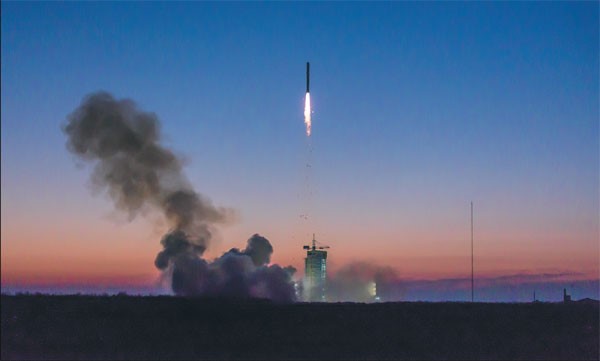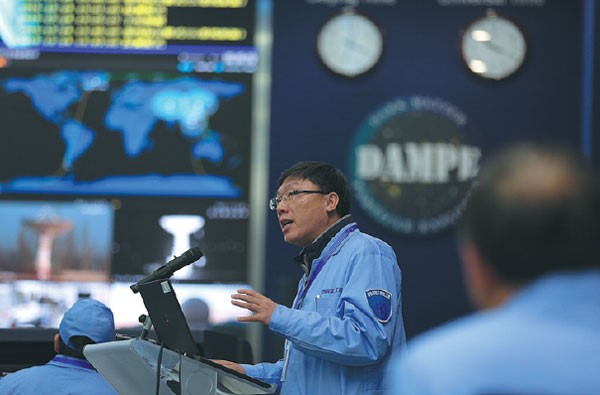The intrepid bearers of the celestial sword
A group of Chinese scientists have something on their mind, and it does not get any darker than this.
This is a search unlike any other: It's going on in the darkness of outer space, and the hunters have no idea where their quarry is or when it will pop up. In fact they do not know what they are searching for looks like either. One of those hunters is Chang Jin, who says: "It must be there. But we don't know if we will be lucky enough to catch it, or even whether it's a bear or a rabbit."
Chang is chief scientist on China's Dark Matter Particle Explorer (Dampe) program, and he and others working on it seem to be a breed apart, as unusual as the enigmatic matter they are looking for. It is not unknown for Chang to be at home and, as though lost in space, to be mumbling numbers to himself; Another researcher, Fan Yizhong, 38, talks of insomnia and of dark-matter worries that have turned his hair white.

A rocket carrying the dark matter particle explorer takes off from Jiuquan Satellite Launch Center in Gansu province on Dec 17. Yu Fei / For China Daily

Chang Jin delivering a report as the satellite began sending scientific data home. Jin Liwang / Xinhua
The best clues to what these scientists are looking for are hidden in chains of figures and diagrams being fed into computers in a nondescript building in downtown Nanjing, Jiangsu province, that houses the Purple Mountain Observatory. The data those computers receive comes from the explorer, which is circling the planet, not far above our heads in low-Earth orbit.
Scientists believe that only about 5 percent of the total mass-energy of the known universe is made up of ordinary matter - protons, neutrons, electrons - and that dark matter and dark energy make up the rest.
Dark matter, like a ghost of the universe, does not emit or reflect enough electromagnetic radiation to be observed directly, and is one of the great mysteries of modern science.
Dark matter is a theory of scientists perplexed by the missing mass and strangely bent light from faraway galaxies and is widely accepted in the world of physics even though its existence has never been proven.
Understanding dark matter could, therefore, give us a clearer idea about the past and future of galaxies and the universe, and will be revolutionary for the fields of physics and space science, Chang says.
The universe hides its secrets well, and the hunters need a good tool to help them with their search.
Scientists compare the explorer, nicknamed Wukong or Monkey King, to a sword sweeping for traces left by the "ghost" of the universe using the widest-ever observation spectrum and highest-ever energy resolution equipment of any probe in the world.
The satellite was put into orbit on Dec 17, and since the launch Chang has worried day and night whether its 76,000 small detectors are working properly; whether the data are reliable; whether the storage and computing capability of the computer are enough.
The cost of Dampe, $100 million, is only one seventh that of NASA's Fermi Gamma-Ray Space Telescope and a 20th that of the AMS-02 particle detector on the international space station. Chang argues that the satellite will be worth every cent spent on it.
When he started work at the Purple Mountain Observatory in 1992 he chose to specialize in the observation of high-energy electrons and gamma rays because no scientist had done that before.
However, it required expensive equipment that China could ill afford in the 1990s. So Chang developed a new and cheaper method of observing high-energy electrons and gamma rays.
He convinced scientists in the United States to include his observation method in the Advanced Thin Ionization Calorimeter program, in which an instrument was flown in the stratosphere over Antarctica in a balloon beginning in late 2000, the aim being to measure the energy and composition of cosmic rays.
The data analysis revealed an unexpected surplus of high-energy electrons that could not be explained by the standard model of cosmic ray origin, in which electrons are accelerated in sources such as supernova remnants and then propagate through the galaxy.
Chang believes the surplus possibly resulted from the annihilation of dark matter.
Chang and his partners improved their equipment and streamlined their methodology, and conducted three observations above Antarctica after the initial one.
Chang spent nearly 10 years analyzing the data, and his wife recalls his trance-like state at home, whispering strings of numbers. When a new idea sprang to mind, he would rush to the laboratory to write a program to do calculations.
Does the surplus of high-energy electrons come from annihilation of dark matter? Data from the Advanced Thin Ionization Calorimeter cannot exclude interference from other celestial bodies. As long as the balloon is in the atmosphere, the high-energy particles will collide with the atmosphere and cause a lot of noise. A probe must be sent into space for a clearer observation, Chang says.
Chang submitted his first application for developing a dark matter space probe in 2002 but received no response. He tried again in 2003 but failed again.
During those years, Chang and his team took part in the development of scientific payloads on China's Shenzhou spacecraft and Chang'e lunar probes, and won many accolades. All the while he persevered in his lonely quest for dark matter. He did countless calculations and experiments and kept refining and updating complex technologies.
In 2008 Chang published an article in the journal Nature as the first author, introducing the discovery of the abnormal surplus of high-energy electrons. The discovery was regarded as one of the important research advances in physics that year.
Experts say that if confirmed, the observation would be the first evidence of annihilation of dark matter particles found by mankind. After that finding was published there was a global scramble to detect dark matter.
In 2011, Chang's dream finally began to be realized: China inaugurated a program to develop a series of scientific satellites including Dampe.
Since Dampe was put into orbit, scientists have been calibrating the satellite in order to produce more accurate data.
"Now the payload looks perfect, but it's not enough," Chang says. "If the calibration goes well, the signs we seek will pop out from the data."
Wukong is sending back about 20GB of data a day. Zang Jingjing, a Dampe advanced data process sub-system designer, says all the data will be analyzed by a special computer equipped with 128 10-cored CPUs.
"After calibration, the detectors will collect more useful data and screen out signal noise," Zang says. "That will save a lot of time.
"The accuracy for detecting the direction of incoming particles can reach one hundredth of a hair's width. That will indicate where the particles come from. If they are from the dark matter, we will know the location."
Prototypes of instruments to be used in the Dampe research were taken to CERN, the European Organization for Nuclear Research, to be calibrated, the first time this has been done with a large detector from China.
Zang took part in all the calibrations. Each time, he lost about 5 kilograms in weight, he says. "Although it was laborious, we were pursuing our dream."
The chief scientific applications designer for Dampe, Wu Jian, 46, says scientists in China are not that well paid, particularly if you compare them with doctors or company bosses. "But doing things I'm interested in gives me satisfaction. If we make some discovery we are going to add to humanity's knowledge.
"What interests us are the gaps in science, the areas most likely to yield new discoveries," says Wu, who worked in the data analysis team led by the Samuel Chao Chung Ting, who won the Nobel Prize for physics in 1976, in Zurich for two years. "It's like a sweet potato field. If the field has been dug many times, it's difficult to harvest anything."
Another of the scientists working on the projects is Fan Yizhong.
"I'm younger than I look," says Fan, 38, referring to his gray hair.
Fan, the deputy chief designer of the scientific application system for Dampe, and his team are responsible for analyzing the signals Dampe detects and identifying whether they are from dark matter or are other interesting astronomical phenomena.
Born into a poor family in a rural area of Chongqing in southwest China, Fan went to a technical secondary school, his parents hoping he could get a job as early as possible to help the family financially. Supported by his brother, he went to college and became fascinated by astronomy after reading books by the British physicist Stephen Hawking.
He obtained a master's degree in astrophysics at Nanjing University and a doctorate at the Purple Mountain Observatory, and then studied in the United States, Israel and Denmark. For 10 years he studied gamma ray bursts, a kind of supernova explosion during the death of a star.
When he applied for a job at the Purple Mountain Observatory in 2010 he was asked to switch to researching dark matter because the Dampe program was being considered.
Since then he has been obsessed by dark matter.
"It's really mysterious. What attracts me most is that we know almost nothing about it," Fan says.
"When can we find dark matter? Nobody can tell. Maybe tomorrow, maybe in several years."
But he believes the satellite is bound to make exciting findings whether about dark matter or other astronomical phenomena.
Fan says his hair turned gray after the Dampe program started. Because China has so few scientists in the field of dark matter, he has difficulty recruiting suitable researchers. He suffered insomnia for a long time worrying about his team, he says.
Some universities offered him positions with better pay, but he declined.
"This is China's first astronomical satellite. We are blazing a trail for China's space exploration. It is a once-in-a-lifetime opportunity." (China Daily USA 03/07/2016 page7)


